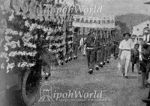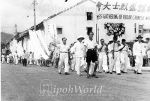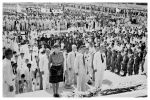We've tried to ensure the information displayed here is as accurate as possible. Should there be any inaccuracies, we would be grateful if you could let us know at info@ipohworld.org . All images and content are copyright.
(Please click on the thumbnail for a bigger image.)
Colonel Lim Bo Seng, Force 136, Is Reburied In Singapore





The first and second photographs (left abd centre) show the reburial parade for Colonel Lim Bo Seng of Force 136 in the streets of Ipoh, prior to being returned to Singapore, his home town. In the first picture the hearse is leading the parade with an armed military contingent immediately behind it. This photograph is taken from the book Kinta Valley.The second photo, supplied by Ian Anderson, has a banner proclaiming the grroup to be to be a Gathering of Perak Chinese Workers.
The third, fourth and fifth photographs are supplied by Ipoh Remembered about which he says:
"First there is a copy of a photograph taken at Lim Bo Seng's memorial service in Singapore (13 January, 1946). At the microphone is Pat McKerron, whom you may recognise or remember.
The scene is the old Municipal Building, across from the padang(This second photograph was taken some years before the war.). It was City Hall in the '50s and after, but I think now it's part of Singapore's National Gallery."
The History
Lim Bo Seng, born in Singapore in 1909, went to an Anglo-Chinese School in Swatow, China, before returning to study at the Raffles Institute at age 16. He was actively supporting the Chinese by organising relief funds and the boycott of Japanese goods after the Japanese attacked in 1937. His commitment to Chinese resistance increased with the Japanese invasion of Malaya. Just before the fall of Singapore he and other community leaders who were targeted by the Japanese sailed via Sumatra for India. There he was recruited by Force 136.
Before the Japanese attacked Malaya, a potential resistance organisation already existed in the form of the Malayan Communist Party. This party's members were mainly from the Chinese community and totally anti-Japanese. They formed the Malayan Peoples' Anti-Japanese Army, and their first members were trained by British officers such as Freddie Spencer Chapman. Although they mounted a few operations against the Japanese lines of communication during the invasion of Malaya, they were cut off from the Allied commanders with the fall of Singapore.
Using organisers and agents such as Lim Bo Seng, Force 136 was able to re-establish contact with the MPAJA, which had continued to exist in camps deep inside the jungle.
Lim Bo Seng recruited around a hundred Malayan Chinese students in Chongquing to join the espionage work. Following military training in India from the British the agents were sent by submarine to Malaya. As leader of the Malayan Chinese section Lim Bo Seng arrived in November 1943 to co-ordinate the Chinese resistance efforts.
The small force made contact with Chin Peng who represented Perak MPAJA (Malayan People's Anti Japanese Army) HQ. He and his colleagues were actually Communists and members of the Communist Party of Malaya (MCP) but it was agreed that in exchange for arms, finance and training, the guerillas would be ready to play their part and support the British against the Japanese when the invasion of Malaya took place. On January 1st 1944 Lim Bo Seng, Major John Davis, Captain Richard Broome and Lai Teck of the MCP signed the Bukit Bidor Agreement committing themselves to joint military effort against the Japanese.
Lim Bo Seng was a Malayan Kuomintang (KMT) member and an agent of the Chinese government in Chungking. The Chinese agents (from Kuomintang), trained in wireless operations and intelligence work, set themselves up in a cover job in Ipoh. A spy network was established under the cover of a rice importing company named Jian Yik Jan, to buy up all the smuggled rice in Pangkor, in order to aggravate a food shortage in Malaya, as a means of economic sabotage.
In March 1944, the cover was blown and all the important agents in the spy ring were rounded up. Warned of danger, Lim Bo Seng left his base at 12 Silibin Road and tried to escape to Bidor, but was arrested by Kampeitai on the Gopeng-Kampar Road. Lai Teck, actually a Japanese agent, had informed the Kempeitai of Lim Bo Seng’s movements. All the Force 136 agents caught were interrogated and tortured at the counter-espionage headquarters at 7 Chapman Street. Lim Bo Seng died from his injuries in the Batu Gajah prison on 29 June 1944.
Originally buried by the Japanese in a mass grave next to the prison in June 1944 his remains were exhumed after the war. They were carried through the streets of Ipoh, stopping at the Jian Yik Jan shop, escorted by British troops, Chinese guerillas and local citizens (pictured). They were then transported to Singapore where they were reburied with full military honours on January 13 1946.
To find out more about The Malayan People’s Anti-Japanese Army (MPAJA), click here.
TV Drama "The Price of Peace"
The Price of Peace is a Singaporean television drama set in Japanese-occupied Singapore during World War II. It was first aired on TCS Eighth Frequency (now MediaCorp Channel 8) on 30 June 1997. Although the drama was originally in Mandarin, an English-dubbed version was also broadcast on TCS Fifth Frequency (now MediaCorp Channel 5) in 1999. The drama has been rerun on MediaCorp Channel 8 several times since its premiere and its latest airing was in August 2013. The series is based on a 1995 book of the same title (published by Asiapac Books), which contains numerous first-hand accounts of war veterans and eyewitnesses.